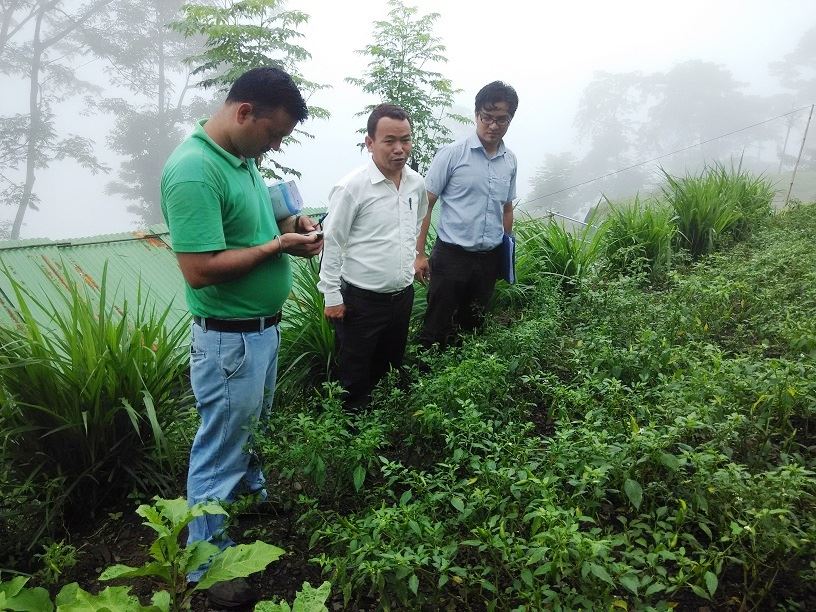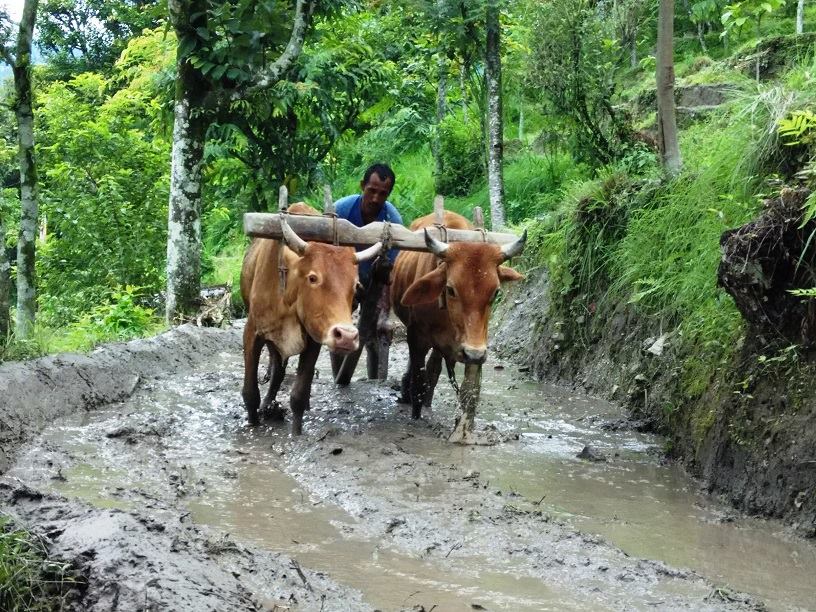This story was originally published by Reasons to be Cheerful
In Pelling, a town in Western Sikkim in India with the best views of the Himalayan peak Kanchenjunga, Tsering Bhutia gazes at the terraced field behind his house. “We’ve grown organic black cardamom for years,” he says. “But ever since a blight destroyed my crop, I’ve been contemplating making a homestay here instead…” About two miles away, Rinchen Lama adds homegrown vermicompost to her field. “The squash I grow is the most delicious you’ll ever eat,” she says. “But my kids also like other vegetables, so I get them from the market.”
In a state that officially went 100 percent organic in 2016, and won what many regard as the Oscar for best public policies — the UN Food and Agriculture Organisation’s Future Policy Gold Award — in 2018, such stories paint an honest picture of the challenges that arise in fundamentally altering how our food is grown. But this change is necessary: An estimated 52 percent of agricultural land across the globe is moderately to severely degraded due to monoculture, chemical pesticide and fertilizer use, and groundwater extraction — and this will accelerate unless these practices change. And in 2019, a United Nations Environment Programme (UNEP) report found that commercial food production over the last 50 years has driven more biodiversity loss globally than any other activity.
When it comes to organic farming, Australia leads the world’s tally with 53 million hectares under cultivation, and at 4.7 million hectares, India stands a far second (the United States, at 2.06 million hectares, is ninth). Not many countries and regions have managed to transition to 100 percent organic food production, as it is tricky and initially expensive. Here’s how Sikkim succeeded where Sri Lanka failed disastrously.
Lessons from a failed experiment
In 2021, Gotabaya Rajapaksa, president of Sri Lanka, declared an overnight ban on the use and import of chemical fertilizers and other crop inputs in the country. A survey at the time found that over 90 percent of the two million farmers in the island nation used chemical fertilizers and 85 percent expected huge reductions in their harvest if they stopped suddenly.
Indeed, the ban, coupled with the higher production expenses, devastated food production. The government was not able to supply enough organic fertilizers, or import sufficient soil nutrients to satisfy farmers’ requirements, before banning agrochemicals. Consequently, the production of rice (a significant staple on Sri Lankan plates) dropped by half, and the production of tea, Sri Lanka’s largest cash crop, fell by 18 percent. In 2022, food shortages and a worsening foreign exchange crisis forced the government to call off its experiment with organic farming. The World Food Programme estimated that in 2023, 17 percent of its population of 22 million remained food-insecure, an improvement on 2022’s figure of 28 percent.

In comparison, Sikkim chose the slow route: Back in 2003, the state gave itself a decade to transition to 100 percent organic. The odds were in its favor. Sikkim is India’s most sparsely populated state (86 people per square kilometer, as per the 2011 census, compared to 828 in the North Indian state of Uttar Pradesh). Its mainly subsistence farms were, and continue to be, spread thinly across mountainous terrain, which makes supplying inorganic fertilizers expensive. Consequently, using homegrown organic manure and vermicompost (compost created from worm waste) was very much the norm. In fact, Sikkimese farmers were already using less nitrogenous and phosphatic fertilizers in 2003: merely 9.9 kg per hectare of cropped area, compared to Punjab (172 kg per hectare) and Haryana (150.4 kg per hectare). It also helped that the local populace already understood the value of organic food. “As children, we were taught that basti (local) vegetables grown without any chemical inputs by small farmers, were the best vegetables to eat,” says Renzino Lepcha, CEO of Mevedir, an organic agri-business and certification agency in Sikkim. “And we chose them over those imported from the plains.”
“We’ve borrowed this earth from our future generations…”
The state’s organic journey kicked off in 2004, with an action plan in which the then-chief minister Pawan Chamling wrote, “[W]e have not inherited this earth from our forefather but have borrowed it from our future generations, it is our duty to protect it by living in complete harmony with nature and environment.” This lofty idea was accompanied by pragmatism: At this juncture, the subsidy on chemical fertilizer was merely reduced (it was fully banned in 2014). The state government developed 100 model villages where organic farming was demonstrated, and as most landholdings were small, encouraged farmer-producer groups to collectively apply for organic certification. This was provided initially through certification agencies like Mevedir, and later, starting in 2015, through the newly-minted Sikkim State Organic Certification Agency.
Crushed by negative news?
Sign up for the Reasons to be Cheerful newsletter.
In 2010, the Sikkim Organic Mission, the nodal agency that implemented the state’s organic policy, was formed. “We underwent many training modules and learned about different aspects of organic farming — making fertilizers and crop medicines from cow dung and urine, multi-cropping, crop rotation, composting, etc.,” Bhutia, the farmer in Pelling, recalls. “Most of these were easy, and cheap to adopt.” By 2016, when the state government and contracted agencies had certified more than 75,000 hectares of land, the state was declared to have become 100 percent organic.
But even though the transition was leisurely and well-planned, Sikkim faced — and continues to face — challenges.
“Why export organic pineapples — and eat non-organic fruit at home?”
In 2022, 82 percent of the respondents in a study of the state by the Ashoka Trust for Research in Ecology and the Environment (ATREE), a nonprofit focused on conservation and sustainable development, reported that they still source their staple food from the market or through the public distribution system. “And this is not necessarily organic,” Sarala Khaling, an ecologist and interdisciplinary researcher at ATREE, says. “Farmers are growing more cash crops than food crops,” she says, describing the state’s changing foodscape, which is influencing what farmers are choosing to grow — or not grow. “I’ve seen many farms abandoned for reasons including economic unviability, climate uncertainty, reduced land holding sizes and loss of interest in farming among the youth.”

This declining interest in farming has been exacerbated by a drop in agricultural production between 2017 and 2020, and the lack of agricultural infrastructure to make agribusinesses financially feasible (which could make farming more attractive to the younger generation). “Initially in 2006, we started sending ginger and turmeric to Holland and Germany by air,” Lepcha says. “But in the absence of any cold chain infrastructure, our export volumes were so small that they weren’t commercially viable.”
There has been a decline in political interest in organic farming in Sikkim as well. In the 2019 Assembly elections, the political party Sikkim Democratic Front, led by the erstwhile chief minister Pawan Chamling, lost to the Prem Singh Golay-led Sikkim Krantikari Morcha. Chamling, a farmer who had served five consecutive terms as chief minister of Sikkim, had spearheaded and overseen the transition to organic. But the new government, Lepcha observes, has different priorities. “Five years ago, the Krishi Bhawan (Department of Agriculture) used to be buzzing with daily meetings, training sessions and seminars on organic agriculture,” he says. “Today, there are hardly any.”
The return of the bees
On the bright side, studies and field observations indicate that Sikkim’s fragile mountain ecology is thriving today. “We can actually see on the ground that going organic has improved the soil quality and biodiversity in the areas that we work,” Lepcha says. Mevedir presently works with 30 farmer groups across three districts in Sikkim. “Most farmers we work with experience the positive effects of going organic, and it certainly helps that homemade crop inputs are way cheaper than buying their chemical counterparts,” he says.

Rain-fed agriculture has helped reduce the need for irrigation and conserve water, a scarce commodity in the Himalayas. Some reports suggest that since 2014, bee populations have been rebounding, with yields of pollinator-dependent cardamom increasing by more than 23 percent. The organic tag is also fueling an increase in wellness tourism, and tourist arrivals in the state have increased by 25 percent since 2016. Khaling sounds a warning note here, however, saying that she is apprehensive about “opening the floodgates of an ecologically fragile zone to mass tourism.”
Even though the government focus on organic agriculture has lessened, Lepcha says that farmers supplying to Mevedir continue to practice it. Marginal farmers like Bhutia and Lama prefer the organic way as well.
“Sikkim isn’t a failed model, but it isn’t easily replicable either!”
Sikkim’s unique traits — low population density, small landholding size, large natural resource base, historical prevalence of organic farming and most importantly, political will — have lubricated its organic journey. However, as GV Ramanajanegulu of the Hyderabad-based Center for Sustainable Agriculture points out, these traits also make its organic transition hard to replicate. “But while the state’s organic transition may not have been 100 percent successful, it is proof that if a government has the will, it can intervene and transform farming,” he says.
The Sikkim case highlights another key takeaway: Going organic is much more than simply using organic agricultural inputs. It is as much about changing how we grow as it is about changing what we actually eat. Lama’s children groan every time there is squash for dinner, and at Mevedir’s organic vegetable outlet in Gangtok, Lepcha is seeing a growing demand for exotic and out-of-season vegetables like tomatoes. “While this demand exists, vendors in Sikkim will be forced to import from other parts of the country,” he says.
Khaling and her colleagues at ATREE suggest that it would be more transformative to broadly uphold all the principles of agroecology (the complex interrelationship between people, food production, livelihoods and the environment) instead of narrowly focussing on organic farming alone. “Replenishing the water and soil used for farming, eating what we’re producing, allowing biodiversity and domestic animals to thrive alongside farms and most of all, ensuring that farming practices improve the lives and lifestyles of the farmers themselves, could improve the Sikkim model,” she says.
Meanwhile, Lama’s children noisily protest against squash being on their dinner menu yet again, and once again, for a little variety, she buys some potatoes from the local market to cook into a curry.
The post How One Indian State Went 100% Organic appeared first on Reasons to be Cheerful.




